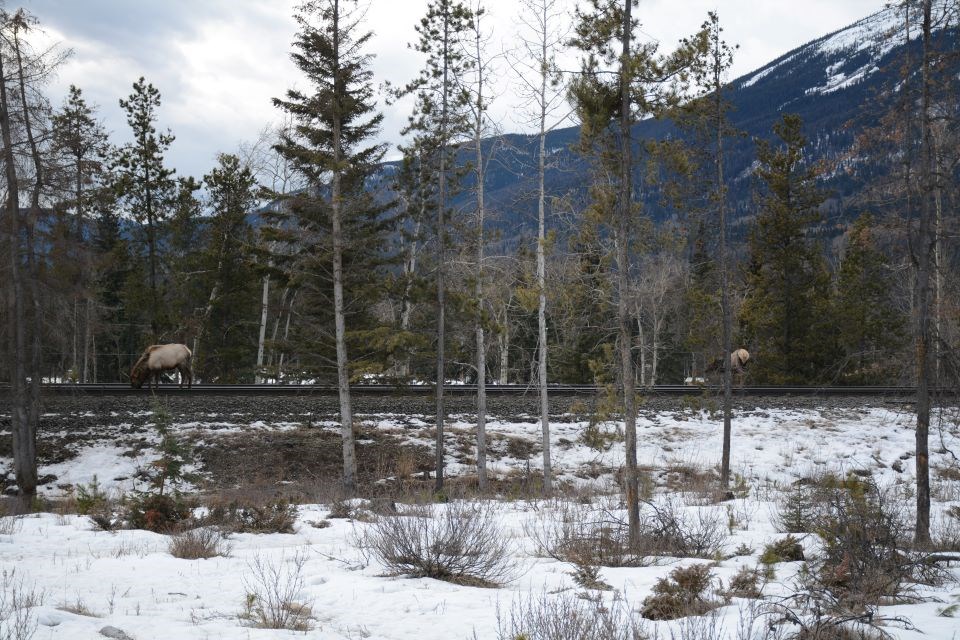Elk in Jasper National Park have been snacking in an unusual and dangerous place.
According to Canada’s National Parks Wildlife Regulations, “no person shall … touch or feed wildlife in a park or entice wildlife that is in a park to approach by holding out or setting out decoys or any such devices, foodstuffs or bait of any kind.”
If a camper left food unattended on a picnic table, that person is subject to a fine. Last September, for example, a motorist was fined $1,500 for throwing objects at a grizzly sow and her two cubs along Maligne Road.
The issue came back to the spotlight recently as elk have been observed apparently eating off the train tracks.
“Does Parks Canada fine Canadian National Railway Company daily for feeding the wildlife? Not to mention the number of animals hit by trains each year…because they are feeding off the grains, etc on the tracks,” was posted on Jan. 27 on the Today in Jasper page on Facebook.
While grain and other materials infrequently spill from the train cars, CN does not face the same charges.
The Railway Safety Act sets out requirements for anyone operating over the tracks of a federally regulated railway, said Hicham Ayoun, senior communications advisor with Transport Canada, in an email to the Fitzhugh.
“Under the Act, railway companies are responsible for the safety of their rail line infrastructure, railway equipment and operations,” Ayoun wrote.
“This includes ongoing inspection, testing and maintenance programs in accordance with regulatory requirements, as well as any operating and environmental conditions. It also includes the removal of anything that might constitute a threat to safe railway operations.”
Transport Canada verifies regularly whether federally regulated railway companies are compliant with the Railway Safety Act and conducts audits to confirm compliance.
“Transport Canada will not hesitate to take enforcement actions when necessary,” Ayoun added.
The land on which the train tracks go through Jasper National Park is considered CN’s right of way, and the public company is responsible for its activities within that area, said Dave Argument, resource conservation manager with Jasper National Park.
That right of way is variable down the length of the track, but in most areas, it is between 30 and 50 metres from the centre of the track.
“The grain spill issue specifically is a pervasive issue that is really, really challenging,” Argument said.
“My understanding is that the leakage from cars as they're rattling down the tracks, that happens throughout the length of the track. There have been efforts over the years to look at [that], to assess that and to try to find solutions. But it's a challenge that there is no readily available or simple solution for.”
CN reports to Parks Canada when a significant spill has occurred, such as the December 2015 incident when 12 railcars derailed, six of which spilled their load of 500 tonnes of grain into the Athabasca River. Argument said it is the company’s responsibility to clean spills up.
“There have been various methods used like a vacuum truck that can suck up the grain. Sometimes it's a matter of brooms and shovels, but understanding of course, that once grain gets down into that ballast, it can be hard to clean up all of the grains that will actually get down in between the rocks.”
Naturally, wildlife are attracted to any remaining grain, the consequence being that they impede freight traffic. Collisions occasionally occur as well.
According to statistics provided by Jasper National Park, 591 elk have been killed on train tracks through the Park from 1980 to 2023. The data, which also tracks mortality of other species including moose, bears and caribou, tabulates a total of 1,581 animals killed in that period.
Last year alone, 10 elk, two moose, four white-tailed deer, one bighorn sheep, seven black bears and one lynx were killed on the tracks.
“What we do is work co-operatively with CN to try to minimize wildlife mortality,” Argument said.
“We ask that they report grain spills when they occur, and if appropriate, we'll work with them to clean those up. We also do things like … reporting and removal of wildlife carcasses where things are struck, which is important to reduce further wildlife collisions.”
The Fitzhugh reached out to CN for an interview on how spills occur and what measures CN is taking to minimize or stop them in the future.
“CN continues to invest in new hopper cars which will reduce the frequency of grain spills. Local crews clean up spilled grain as it is found. CN staff also work closely with Jasper National Park staff on wildlife management systems,” responded Julianne Threlfall, CN’s manager of public affairs for Alberta and the Northwest Territories.
When asked for more information about how exactly the spills occur from hopper cars, how new hopper cars will prevent the problem and what other measures CN might consider, Threlfall responded that CN’s comments are restricted to the statement already provided at this time.



